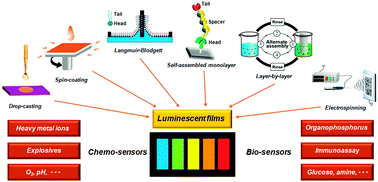Luminescent films for chemo- and biosensing
Abstract
Luminescent films have received great interest for chemo-/bio-sensing applications due to their distinct advantages over solution-based probes, such as good stability and portability, tunable shape and size, non-invasion, real-time detection, extensive suitability in gas/vapor sensing, and recycling. On the other hand, they can achieve selective and sensitive detection of chemical/biological species using special luminophores with a recognition moiety or the assembly of common luminophores and functional materials. Nowadays, the extensively used assembly techniques include drop-casting/spin-coating, Langmuir–Blodgett (LB), self-assembled monolayers (SAMs), layer-by-layer (LBL), and electrospinning. Therefore, this review summarizes the recent advances in luminescent films with these assembly techniques and their applications in chemo-/bio-sensing. We mainly focused on the discussion of the relationship between the sensing properties of the films and their architecture. Furthermore, we discussed some critical challenges existing in this field and possible solutions that have been or are being developed to overcome these challenges.


 Please wait while we load your content...
Please wait while we load your content...